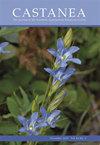New Populations of the Rheophytic Macrophyte Podostemum ceratophyllum Michx. (Hornleaf Riverweed) in West Virginia
IF 0.3
4区 生物学
Q4 PLANT SCIENCES
引用次数: 1
Abstract
ABSTRACT Podostemum ceratophyllum (Hornleaf riverweed) is a macrophyte that inhabits swift-water rivers with stable substrates and abundant light in montane and piedmont ecoregions of eastern North America. Within these habitats, P. ceratophyllum is considered a foundation species because the plant can strongly influence community structure by increasing habitat complexity for macroinvertebrates and fishes, and facilitates resources cycling via elemental sequestration, herbivory, and detrital pathways. Currently, the USDA and NatureServe recognize P. ceratophyllum as a conservation concern in some states, but the plant's status remains uncertain in many other states. In West Virginia, P. ceratophyllum is considered imperiled (S2) by the West Virginia Natural Heritage Program. The most recent records were collected in 1998, while other populations have not been confirmed since the late 1800s. To expand our current understanding of the distribution of P. ceratophyllum in West Virginia, we surveyed six historical sites and 34 new sites between 2015–2019. Four historical sites were found to still support P. ceratophyllum, and 10 new populations were discovered in six different river systems; however, P. ceratophyllum was not found at 26 other sites surveyed. Identifying new populations of P. ceratophyllum and resurveying previously documented populations in West Virginia expands the ecological and botanical understanding of this notably underreported plant. Improved documentation of P. ceratophyllum in West Virginia may benefit river management and restoration efforts in the state and provide insight into the plant's sensitivity to anthropogenic disturbances.标题变生性大型植物角藻的新居群。西弗吉尼亚州的(角叶河草)
角叶河草(Podostemum ceratophyllum)是一种生长在北美东部山地和山前生态环境中基质稳定、光照充足的急水河流中的大型植物。在这些栖息地中,角藻被认为是基础物种,因为该植物可以通过增加大型无脊椎动物和鱼类的栖息地复杂性来强烈影响群落结构,并通过元素固存、草食和碎屑途径促进资源循环。目前,美国农业部和自然保护区在一些州承认角藻属植物是一种受保护的植物,但在许多其他州,这种植物的地位仍不确定。在西弗吉尼亚州,角藻被西弗吉尼亚州自然遗产计划认定为濒危物种(S2)。最近的记录是在1998年收集的,而其他种群自19世纪末以来就没有得到证实。为了扩大我们目前对西弗吉尼亚州P. ceratophyllum分布的了解,我们在2015-2019年期间调查了6个历史遗址和34个新遗址。在6个不同的水系中发现了10个新居群;而在其他26个调查地点未发现角藻。在西维吉尼亚鉴定新种群和重新调查先前记录的种群扩大了对这种明显被低估的植物的生态学和植物学理解。在西弗吉尼亚州,改善对角藻的记录可能有利于该州的河流管理和恢复工作,并提供对植物对人为干扰的敏感性的见解。
本文章由计算机程序翻译,如有差异,请以英文原文为准。
求助全文
约1分钟内获得全文
求助全文
来源期刊

Castanea
生物-植物科学
CiteScore
0.50
自引率
25.00%
发文量
28
审稿时长
>12 weeks
期刊介绍:
Castanea is named in honor of the American Chestnut tree. Castanea is thebotanical name for Chestnuts, dating back to what the ancient Greeks calledthem.
The American Chestnut is a critically endangered tree that once made up 35%of the forests of the Eastern US before being devastated by a blight thatdestroyed up to 4 billion American Chestnut trees.
Castanea serves professional and amateur botanists by reviewing andpublishing scientific papers related to botany in the Eastern United States.
We accept papers relating to plant biology, biochemistry, ecology, floristics,physiology and systematics.
 求助内容:
求助内容: 应助结果提醒方式:
应助结果提醒方式:


